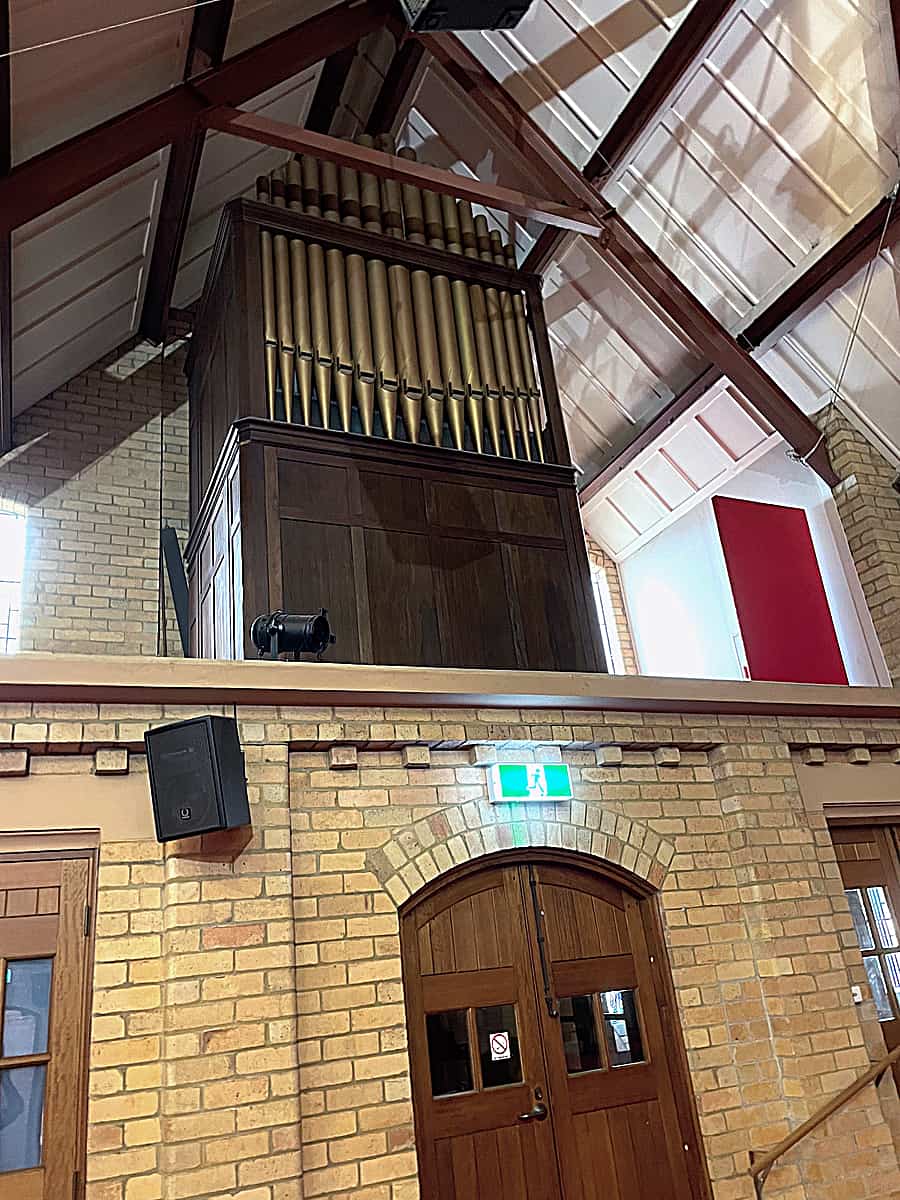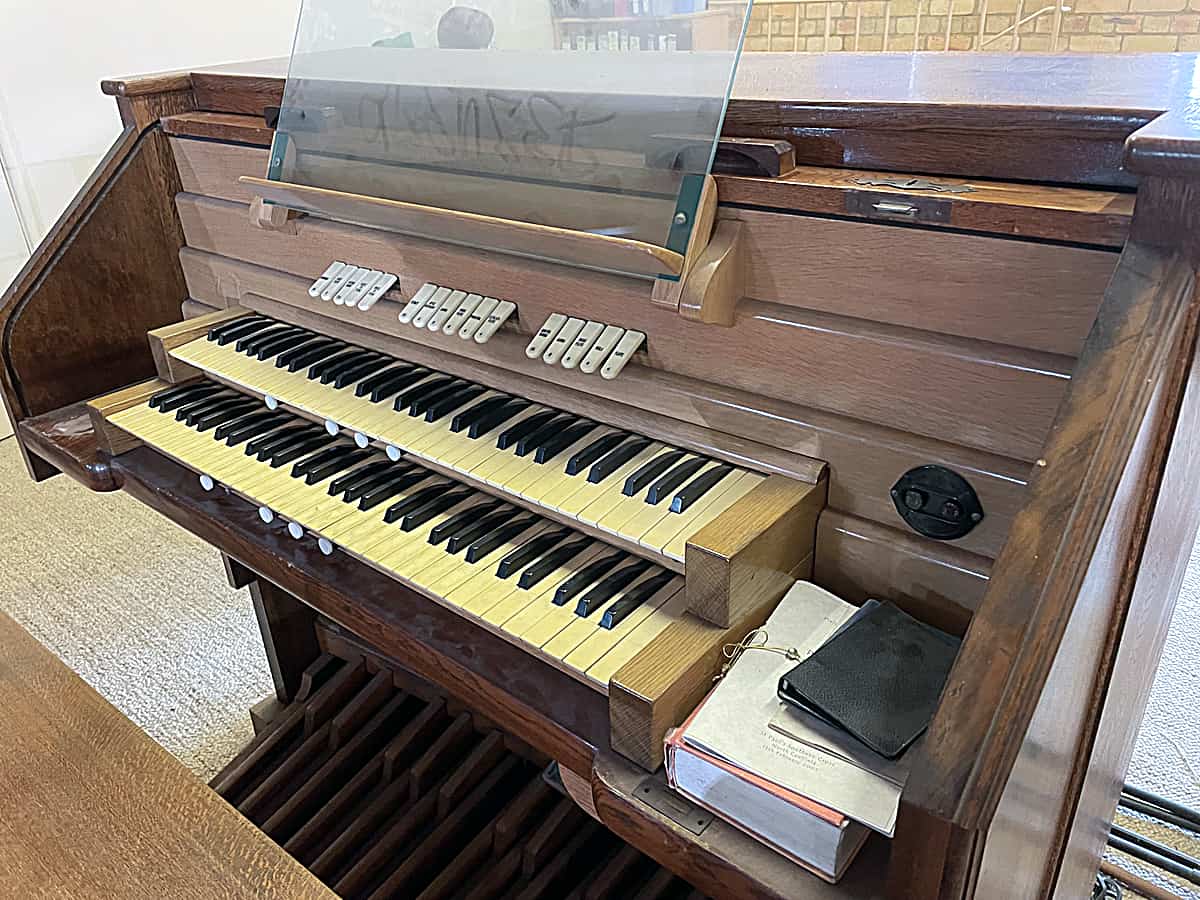
St Paul's Anglican Church, Caulfield – exterior from the south-east
[photograph by John Maidment (28 February 2024)]
Historical and Technical Documentation by John Maidment
© OHTA (last updated March 2024)

St Paul's Anglican Church, Caulfield – exterior from the south-east
[photograph by John Maidment (28 February 2024)]
Historical and Technical Documentation by John Maidment
© OHTA (last updated March 2024)
St Paul's parish dates back to the 1890s and for many years the church consisted of a simple wooden structure.1 The foundation stone of the current church building was laid on 3 December 19382 and was dedicated on 16 September 1939.3 Designed by architect by Louis R. Williams, the façade consists of a lofty tower facing down Glenferrie Road with a central gable incorporating a cross constructed in brick. In 1958, the building was extended through the addition of transepts and sanctuary and in 1961 the lady chapel was built.4 The cream brick interior, with massive roof beams resting upon internal buttresses, consists of a broad nave with a baptistery to the rear and galleried transepts, the left housing the organ and the right the choir and organ console. The original main altar and its cross and candlesticks (probably the work of William Mark) survive. There are fine stained glass windows in the nave, illustrating the life of St Paul, the work of Mathieson & Gibson.5

St Paul's Anglican Church, Caulfield – organ in its earlier location and its original console
[photograph from Ring Out Wild Bells, page 41]
The organ was built in the London factory of William Hill & Son and Norman & Beard Ltd, 372 York Way, Islington – the firm's English job number 2726 – cost £750.6 It was one of the first organs to be exported to Australia by the firm and constructed before it had fully set up its own factory in Melbourne. It was constructed on the extension principle, with three basic ranks operating on electro-pneumatic technology. It had an attached drawstop console.7 The firm produced many instruments in this genre, particularly its "Christie" theatre organs. The gift of Albert Wilson, and dedicated on Palm Sunday 1929,8 organ was initially sited to the left of the sanctuary of the earlier wooden church, but was moved in 1939 by Hill, Norman & Beard and finally resited in the completed building in 1958 by Geo. Fincham & Sons Pty Ltd, the organ itself placed on a gallery in the left hand transept and the console opposite in the right hand gallery. At this time the organ was rewired and a new stopkey console supplied. No tonal alterations took place apart from the small addition of an Octave Quint to the Pedal.

St Paul's Anglican Church, Caulfield – organ placed in left hand gallery
[photograph by John Maidment (28 February 2024)]
| GREAT Gedact Open Diapason Gamba Rohr Flute Principal Lieblich Flute |
16 8 8 8 4 4 |
B A C B A B |
unenclosed |
| SWELL Contra Gamba Gamba Rohr Flute Viola Flute |
16 8 8 4 4 |
C C B C B |
bottom octave repeats 8ft octave |
| PEDAL Bourdon Bass Flute Octave Quint Great to Pedal Swell to Pedal |
16 8 5-1/3 |
B B B |
Compass: 61/30
Electro-pneumatic action
Detached stop key console
Adjustable thumb and toe pistons9

St Paul's Anglican Church, Caulfield – organ console
[photograph by John Maidment (28 February 2024)]

St Paul's Anglican Church, Caulfield – console detail
[photograph by John Maidment (28 February 2024)]

St Paul's Anglican Church, Caulfield – Great Open Diapason pipework
[photograph by Daniel Bittner (19 March 2024)]

St Paul's Anglican Church, Caulfield – Swell Gamba and Gedact Pipework – the latter is a harmonic stopped flute in the treble
[photograph by Daniel Bittner (19 March 2024)]
1 https://www.stpaulscaulfieldnorth.com.au/our-history/, accessed 29 February 2024
2 Observed in foundation stone beneath the tower
3 The Argus, 14 September 1939, p.7
4 Ring Out, Wild Bells; Celebrating a Journey of God's People. Caulfield: St Paul's Church, 2004, p.16
5 Ibid., p.18
6 From an unpublished job number listing of organs built by Hill, Norman & Beard compiled by David Wickens
7 Ring Out, Wild Bells, p.41
8 Ibid.
9 Specification noted by John Maidment 28 February 2024